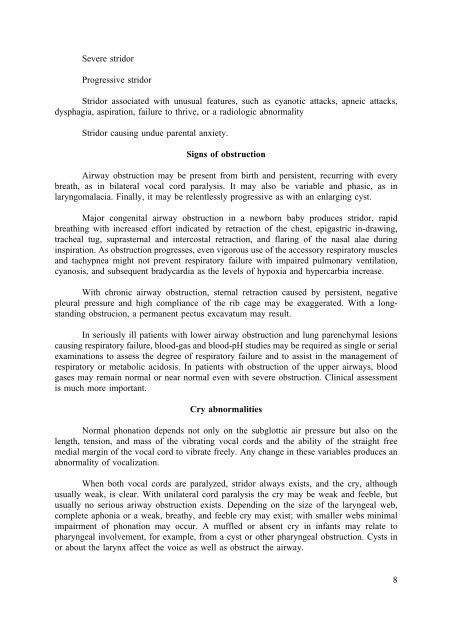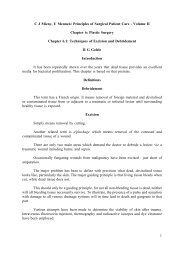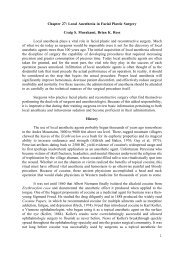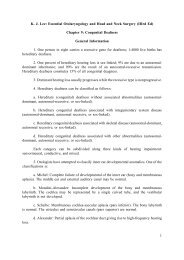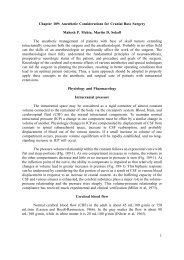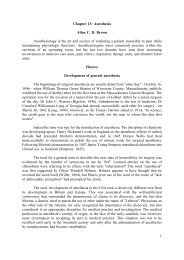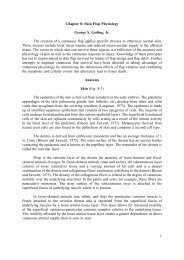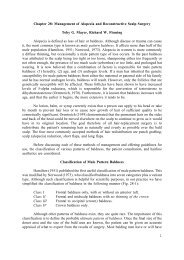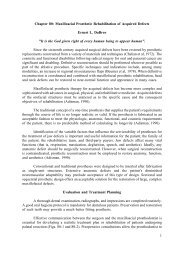1 Chapter 99: Congenital Disorders of the Larynx ... - Famona Site
1 Chapter 99: Congenital Disorders of the Larynx ... - Famona Site
1 Chapter 99: Congenital Disorders of the Larynx ... - Famona Site
You also want an ePaper? Increase the reach of your titles
YUMPU automatically turns print PDFs into web optimized ePapers that Google loves.
Severe stridor<br />
Progressive stridor<br />
Stridor associated with unusual features, such as cyanotic attacks, apneic attacks,<br />
dysphagia, aspiration, failure to thrive, or a radiologic abnormality<br />
Stridor causing undue parental anxiety.<br />
Signs <strong>of</strong> obstruction<br />
Airway obstruction may be present from birth and persistent, recurring with every<br />
breath, as in bilateral vocal cord paralysis. It may also be variable and phasic, as in<br />
laryngomalacia. Finally, it may be relentlessly progressive as with an enlarging cyst.<br />
Major congenital airway obstruction in a newborn baby produces stridor, rapid<br />
breathing with increased effort indicated by retraction <strong>of</strong> <strong>the</strong> chest, epigastric in-drawing,<br />
tracheal tug, suprasternal and intercostal retraction, and flaring <strong>of</strong> <strong>the</strong> nasal alae during<br />
inspiration. As obstruction progresses, even vigorous use <strong>of</strong> <strong>the</strong> accessory respiratory muscles<br />
and tachypnea might not prevent respiratory failure with impaired pulmonary ventilation,<br />
cyanosis, and subsequent bradycardia as <strong>the</strong> levels <strong>of</strong> hypoxia and hypercarbia increase.<br />
With chronic airway obstruction, sternal retraction caused by persistent, negative<br />
pleural pressure and high compliance <strong>of</strong> <strong>the</strong> rib cage may be exaggerated. With a longstanding<br />
obstrucion, a permanent pectus excavatum may result.<br />
In seriously ill patients with lower airway obstruction and lung parenchymal lesions<br />
causing respiratory failure, blood-gas and blood-pH studies may be required as single or serial<br />
examinations to assess <strong>the</strong> degree <strong>of</strong> respiratory failure and to assist in <strong>the</strong> management <strong>of</strong><br />
respiratory or metabolic acidosis. In patients with obstruction <strong>of</strong> <strong>the</strong> upper airways, blood<br />
gases may remain normal or near normal even with severe obstruction. Clinical assessment<br />
is much more important.<br />
Cry abnormalities<br />
Normal phonation depends not only on <strong>the</strong> subglottic air pressure but also on <strong>the</strong><br />
length, tension, and mass <strong>of</strong> <strong>the</strong> vibrating vocal cords and <strong>the</strong> ability <strong>of</strong> <strong>the</strong> straight free<br />
medial margin <strong>of</strong> <strong>the</strong> vocal cord to vibrate freely. Any change in <strong>the</strong>se variables produces an<br />
abnormality <strong>of</strong> vocalization.<br />
When both vocal cords are paralyzed, stridor always exists, and <strong>the</strong> cry, although<br />
usually weak, is clear. With unilateral cord paralysis <strong>the</strong> cry may be weak and feeble, but<br />
usually no serious ariway obstruction exists. Depending on <strong>the</strong> size <strong>of</strong> <strong>the</strong> laryngeal web,<br />
complete aphonia or a weak, breathy, and feeble cry may exist; with smaller webs minimal<br />
impairment <strong>of</strong> phonation may occur. A muffled or absent cry in infants may relate to<br />
pharyngeal involvement, for example, from a cyst or o<strong>the</strong>r pharyngeal obstruction. Cysts in<br />
or about <strong>the</strong> larynx affect <strong>the</strong> voice as well as obstruct <strong>the</strong> airway.<br />
8


